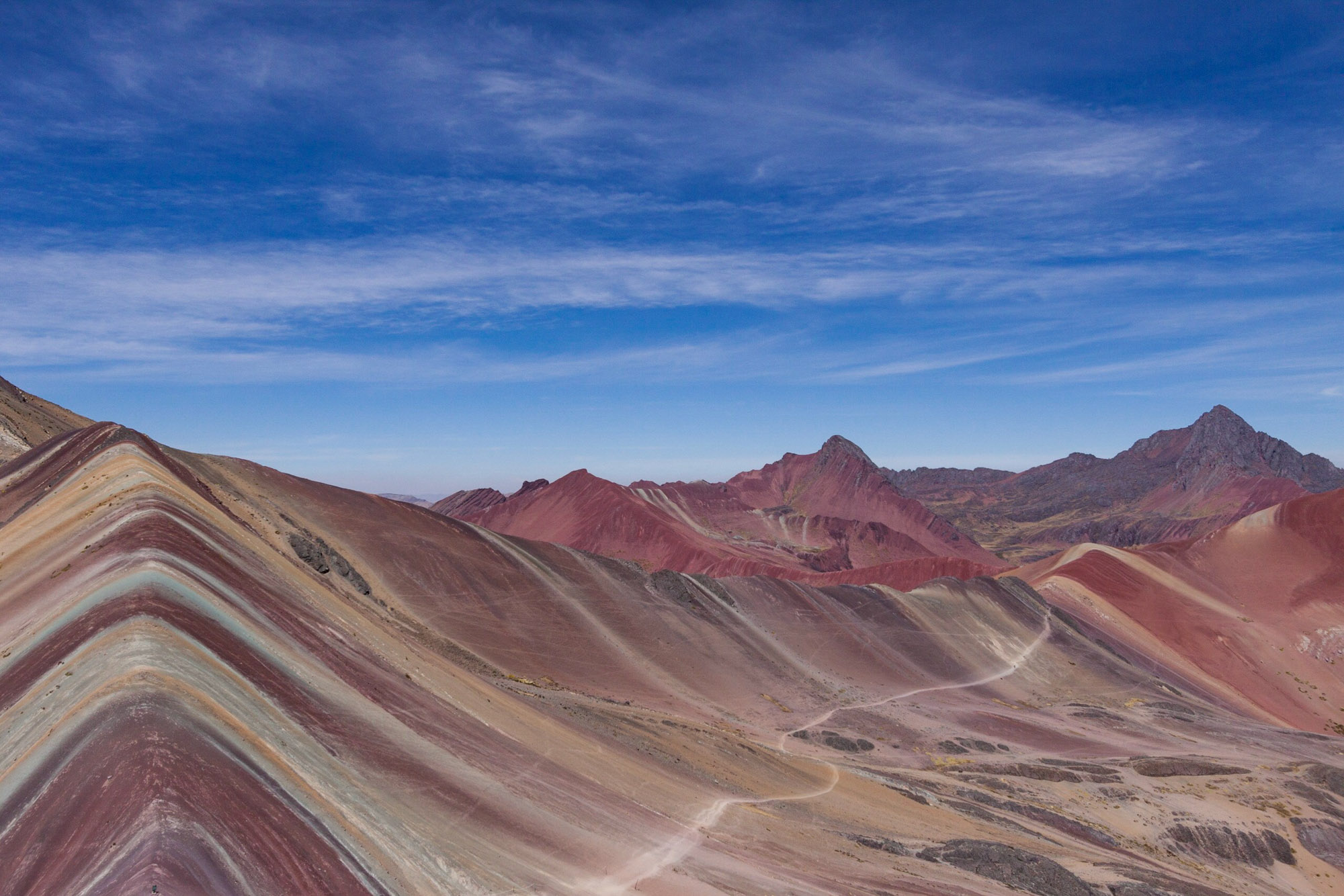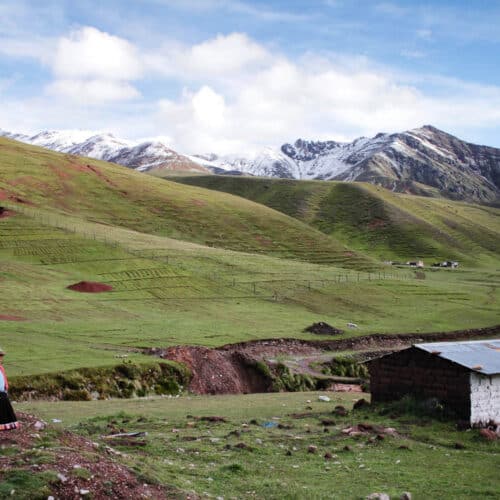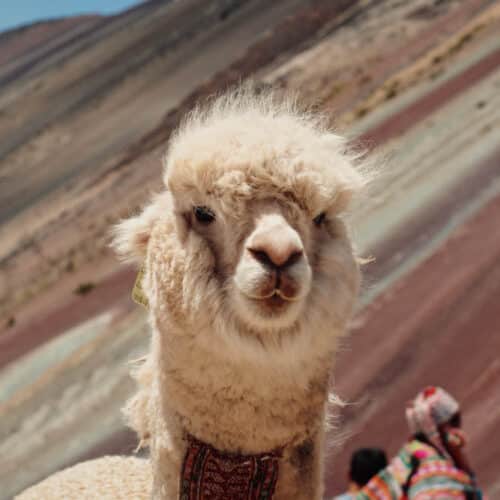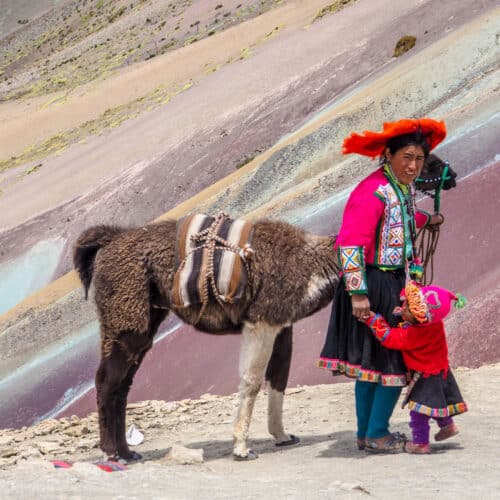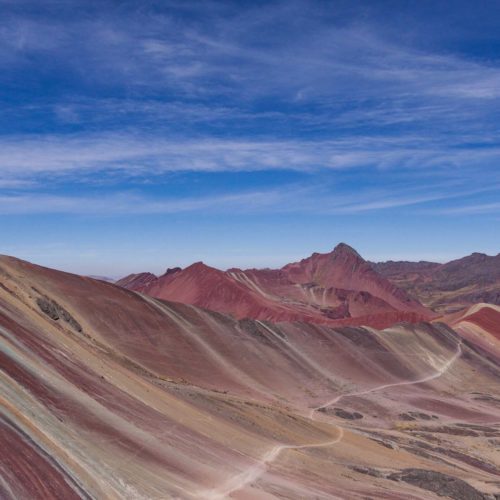Peru’s Rainbow Mountain Guide: Experience Peru’s Colorful Wonder
Rainbow Mountain (Vinicunca) Important Details:
- Address: Rainbow Mountain is located near the village of Pitumarca in the Cusco region of Peru. (Google Maps)
- Hours of Operation: The site is typically accessible year-round, but weather conditions may affect access during certain months.
- Rainbow Mountain Altitude: Approximately 5,200 meters (17,060 feet) above sea level.
- Cost of Rainbow Mountain (Vinicunca): Entrance fees can vary based on the tour operator and inclusions, but below are cost estimates as of 2023:
- Entrance tickets for Vinicunca: ~US$7 (25 Soles pp)
- Entrance tickets for the Red Valley: ~US$5.50 (20 Soles pp)
- Private Tour: US$60 per person (based on 5 people) to US$150+ per person (based on 2 people)
- Horses: US$15 – US$25 (50 – 80 Soles pp)
- Recommended Time to Spend: Plan for a half-day to a full-day trip, departing early in the morning to fully enjoy the experience. Longer if you plan to do the Ausangate Trek.
- How to Arrive: Most travelers reach Rainbow Mountain via guided tours that depart from Cusco.
- Distance From Plaza de Armas in Cusco: Approximately 100 kilometers southeast of Cusco. (Google Maps Route)
- Distance from the Airport in Cusco: The Alejandro Velasco Astete International Airport is around 120 kilometers away. (Google Maps Route)
- Ideal Month(s) to Visit: The dry season from May to September is considered the best time to visit, as the weather is more predictable and the views are clearer.
- Ideal Time of Day to Visit: Early morning is recommended to witness the stunning sunrise over the mountain.
How to Get to Rainbow Mountain (Vinicunca) in Peru
The distance between Cusco and Rainbow Mountain is approximately 100 kilometers (62 miles) southeast of the city. While the distance might seem relatively short, the journey through the Andean landscapes involves navigating winding mountain roads, rugged terrain, and varying altitudes. As a result, the travel time can extend to around three to four hours by road, making the journey an adventure in itself.
Whether you opt for a guided tour, private transportation, or other means, the route from Cusco to Rainbow Mountain takes you through picturesque Andean villages, providing glimpses into the local culture and Peruvian way of life. The journey’s duration is also influenced by factors such as weather conditions, road conditions, and the mode of transportation chosen.
While the mountain’s remote location presents challenges, there are several ways to embark on this unforgettable adventure:
- Guided Tours: Guided tours are the most common and convenient way to visit Rainbow Mountain. Numerous tour operators in Cusco offer all-inclusive packages that take care of transportation, permits, guides, and often meals. These tours depart early in the morning, ensuring you arrive at the mountain in time for the mesmerizing sunrise. The guides offer valuable insights into the geological significance, local culture, and practical considerations, enhancing your experience.
- Private Transportation: If you value privacy and flexibility, arranging private transportation is an option. Hire a driver or rent a vehicle to travel from Cusco to Rainbow Mountain. This approach lets you tailor your schedule and pace while ensuring comfort. This option is the most expensive.
- Hiking and Trekking: For adventure enthusiasts, hiking and trekking are rewarding ways to reach Rainbow Mountain. The Ausangate Trek is a renowned choice, involving several days of hiking through the Andean wilderness, culminating in the awe-inspiring views of Rainbow Mountain. Trekking allows for a deeper connection with nature and local communities but requires more preparation, including acclimatization to the high altitudes. Andean Lodges is our recommended hiking and trekking partner.
- Public Transportation: A budget-friendly option involves using public transportation. Take a local bus from Cusco to the town of Cusipata, which serves as a gateway to Rainbow Mountain. From there, you can arrange for a taxi or use shared transport options to reach the mountain’s trailhead. This approach may take longer and involve more planning, but it offers a glimpse into local life and a chance to interact with fellow travelers.
- Bike Tours: If you’re seeking a unique twist, consider joining a bike tour that combines cycling with a visit to Rainbow Mountain. These tours are tailored for biking enthusiasts and offer a thrilling way to experience the surrounding landscapes. However, be prepared for the physical demands of biking at high altitudes.
No matter which method you choose, prepare for the high altitudes of the Andes. Spend a few days acclimatizing in Cusco before embarking on your journey to minimize the risk of altitude sickness. Additionally, pack appropriate clothing for varying weather conditions, as the climate can change rapidly. At times it even snows at Rainbow Mountain! Whichever path you take, the journey to Rainbow Mountain has stunning views, beautiful geological wonders, and a connection to the natural beauty of the Andes and local communities.
The History and Colors of Rainbow Mountain (Vinicunca) in Peru
Rainbow Mountain, known as Vinicunca Mountain, is a living testament to millions of years of Earth’s intricate processes and geological evolution. Tucked within the Andes of Peru, this remarkable geological wonder has captured the imagination of travelers and scientists. The history of Rainbow Mountain is etched in its vibrant bands of color, each stripe revealing a chapter in the Earth’s ever-changing narrative.
Rainbow Mountain began eons ago when the Andes mountain range was still in its formative stages. Geological forces, both slow and relentless, uplifted layers of sedimentary rock from the depths of the Earth’s crust. Over millennia, these layers were exposed to the elements, resulting in the captivating spectrum of colors that grace the mountain’s slopes today.
The distinct bands of red, orange, yellow, green, and blue that adorn Rainbow Mountain are the result of the mineral deposits within the sedimentary rock layers. Iron-rich minerals contribute to the fiery red hues, while copper and other elements create the cooler blues and greens. Erosion, weathering, and geological upheavals further shaped the mountain’s vibrant palette, revealing the intricate interplay of natural forces over long periods of time.
The geological history of Rainbow Mountain is shown through mineral pigments. With each layer of color, the mountain’s slopes are a canvas portraying the changing landscapes of our planet. When you see Vinicunca, you’re not just witnessing a mountain – you’re gazing upon a record of Earth’s evolution, a testament to the enduring power of nature’s artistry over countless millennia.
Indigenous Andean Communities Around Rainbow Mountain: Guardians of Tradition
The area surrounding Rainbow Mountain is shaped by the rich cultural tapestry of indigenous Andean communities. These communities, nestled amidst the rugged beauty of the Andes, carry a legacy of traditions, customs, and a harmonious connection with the land that stretches back through generations.
A visit to Rainbow Mountain offers travelers a unique opportunity to engage with these communities, gaining insights into their daily lives, traditions, and values. As you explore the area, you might have the chance to interact with local artisans, witness traditional weaving techniques, and even participate in Andean rituals that have been passed down through generations.
The two indigenous tribes that are often in proximity to Rainbow Mountain are the Quechua and the Aymara:
- Quechua: The Quechua people are one of the most prominent indigenous groups in the Andes, known for their profound connection to the land and their ancient language, also called Quechua. Many Quechua communities reside in the Cusco region, near Rainbow Mountain. Their heritage is deeply rooted in agriculture, with traditional farming methods passed down through the generations. Visitors can engage with Quechua communities, learn about their customs, and appreciate their intricate textile work and vibrant festivals.
- Aymara: The Aymara people are another indigenous group with a strong presence in the Andean region. While their heartland lies more to the south, their influence extends to areas near Rainbow Mountain. The Aymara have their language, traditions, and unique way of life. Visitors might have the opportunity to interact with Aymara communities and gain insights into their spiritual beliefs, traditional clothing, and agricultural practices.
Interacting with these indigenous tribes offers a glimpse into the deep-rooted cultures that have shaped the Andean landscapes for centuries. By participating in respectful and responsible tourism, visitors can learn from these communities, support local economies through purchases of handmade crafts, and contribute to the preservation of their cultural heritage. These interactions not only enhance the Rainbow Mountain experience but also foster a mutual understanding and appreciation for the diverse tapestry of human existence that thrives in this breathtaking corner of the world.
Please remember to approach interactions with indigenous communities with sensitivity and respect. As you stand in the shadow of Rainbow Mountain, remember that its vibrant colors are not the only treasures of the landscape; the diverse cultures of the Andean people who call this region home are equally remarkable and deserving of recognition.
What to Do at Rainbow Mountain (Vinicunca)
Rainbow Mountain, the geological marvel known as Vinicunca, offers a range of captivating activities that allow visitors to immerse themselves in its breathtaking landscapes and vibrant colors. Beyond the awe-inspiring views, there are several exciting things to do at this unique destination:
- Trekking and Hiking: The primary activity at Rainbow Mountain is embarking on a trek to witness its colorful beauty up close. The trek to the summit allows you to explore the changing landscapes, from Andean valleys to rugged mountainsides. As you ascend, the beautiful bands of color gradually unfold, creating an unforgettable visual journey.
- Photography: Rainbow Mountain is a paradise for photography enthusiasts. The dramatic interplay of colors against the backdrop of the Andean landscapes provides an array of stunning compositions. Whether you’re capturing the sunrise over the mountain or the intricate details of its vibrant bands, every angle offers an opportunity for breathtaking shots.
- Witnessing Llamas and Alpacas: The area around Rainbow Mountain is often populated by llamas and alpacas, which add an authentic touch to the scenery. These iconic Andean animals graze in the high-altitude pastures, offering a unique chance to observe them in their natural habitat and capture memorable photos.
- Ausangate Trek: For those seeking a more extensive adventure, the Ausangate Trek is an enticing option. This multi-day trek takes you through the stunning landscapes surrounding Rainbow Mountain, offering encounters with local communities, high-altitude lakes, and panoramic vistas that showcase the diverse beauty of the Andes.
- Cultural Interactions: Engaging with the indigenous communities near Rainbow Mountain provides an enriching cultural experience. You can learn about their traditional way of life, witness traditional weaving techniques, and gain insights into their spiritual practices. Supporting these communities through responsible tourism contributes to their sustainability.
- Horseback Riding: Horseback riding is an option for exploring the captivating landscapes around Rainbow Mountain, also known as Vinicunca. This mode of transportation offers a unique and accessible way to experience the stunning natural beauty of the region while minimizing the physical demands of trekking.
Nearby Attractions Around Rainbow Mountain
While Rainbow Mountain itself is a mesmerizing destination, the region surrounding Vinicunca offers a treasure trove of additional attractions that allow travelers to delve deeper into the wonders of the Andes. Here are some nearby places you can explore to enhance your journey:
- Red Valley (Valle Rojo): Situated near Rainbow Mountain, the Red Valley is aptly named for its striking red rock formations. This natural amphitheater boasts breathtaking views and offers a shorter hike that complements a visit to Rainbow Mountain. Red Valley (Valle Rojo) is within walking distance from Rainbow Mountain.
- Ausangate Hot Springs: After a challenging hike or trek, soaking in the Ausangate Hot Springs provides a rejuvenating experience. These thermal springs are located near Rainbow Mountain and offer a relaxing way to unwind while surrounded by natural beauty.
- Puka Pukara: Known as the “Red Fortress,” Puka Pukara is an ancient Inca archaeological site located close to Cusco. It showcases a unique blend of military, religious, and administrative architecture, making it a fascinating historical stop on your journey.
- Queshuachaca Rope Bridge: This ancient Inca rope bridge, located in the nearby region of Canas, offers a glimpse into the engineering prowess of the Inca civilization. Crossing this handwoven bridge is a thrilling experience that provides insights into local traditions.
- Humantay Lake: While a bit further from Rainbow Mountain, Humantay Lake is worth considering for its turquoise waters and stunning views. The lake is surrounded by snow-capped peaks and is a rewarding destination for trekkers.
- Moray and Maras: These archaeological sites offer a glimpse into Inca agricultural innovation. Moray features concentric terraces thought to have been used for experimentation with different crops, while Maras boasts ancient salt pans that are still in use today.
Each of these nearby attractions provides a unique opportunity to delve deeper into the diverse landscapes, history, and culture of the Andes.
Know More About Rainbow Mountain (Vinicunca) in Peru:
Is Rainbow Mountain Safe?
Yes, with the necessary preparations and a guided tour, visiting Rainbow Mountain is generally safe. It’s important to acclimatize to the altitude before the trip.
Is the Rainbow Mountain in Peru real?
Yes, Rainbow Mountain is indeed a real. It has gained international recognition for its vibrant and multi-colored slopes that resemble a rainbow palette. The mountain’s unique appearance is a result of various mineral deposits in the sedimentary rock layers that have been exposed to the elements over millions of years.
What to Pack for Rainbow Mountain?
Pack: layers, such as sweaters or jackets. hiking shoes, a raincoat, caps or hats, sunscreen, sunglasses, plenty of water, local currency (Peruvian Soles), snacks.
Can You Walk There from Other Tourist Attractions in Cusco?
No. The distance between Cusco and Rainbow Mountain makes walking impractical. Guided tours are the most convenient way to get there.
What Is Rainbow Mountain’s Altitude?
The summit reaches an altitude of approximately 5,200 meters (17,060 feet) above sea level. Altitude sickness is a concern, so proper acclimatization is crucial.
Does It Snow at Rainbow Mountain?
Snowfall is possible, especially during the rainy season. It’s advisable to dress in layers to stay warm.
What Minerals Give Rainbow Mountain Its Colors?
The array of colors is a result of various minerals, including iron, copper, sulfur, and more, oxidizing over time. The distinct bands of red, orange, yellow, green, and blue that adorn Rainbow Mountain are the result of the mineral deposits within the sedimentary rock layers. Iron-rich minerals contribute to the fiery red hues, while copper and other elements create the cooler blues and greens.
Are There Llamas at Rainbow Mountain?
Yes, llamas and alpacas are a common sight in the area, often adding to the picturesque landscapes.
What Indigenous Communities Are Around Rainbow Mountain?
Local communities like Pitumarca and Chillca are located near Rainbow Mountain, offering insights into Andean culture.
Why Is Rainbow Mountain Considered a Noteworthy Experience in Cusco?
Rainbow Mountain’s surreal beauty, rich geological history, cultural significance, and the chance to interact with indigenous communities make it a standout experience in Cusco.
What Does an Example of a Guided Tour Look Like?
- Pick you up in Cusco at about 4:30 am
- Cusco to Cusipata by Bus: The bus ride lasts 2.5 hours (Cusipata is located at 3310m)
- Cusipata to Llaqto by Bus: This journey takes about 45 minutes until he town of Llaqto (located at 4630m)
- Hike from Llaqto to Vinicunca Rainbow Mountain: Hike for approximately 1 hour. The hike is relatively easy, except for the last 25 minutes. These last 25 minutes are relatively steep. Vinicunca is located at 5,200 meters (17,060 feet) above sea level.
- Rainbow Mountain Experience: Visitors usually have 30 minutes – 45 minutes of free time on tours.
- Rainbow Mountain to the Red Valley: visitors can walk to the nearby Red Valley.
- Return to Cusipata: Visitors return on foot from Rainbow Mountain to Llaqto, and then take the bus to Cusipata. Lunch is typically had in Cusipata (around 2pm – 2:30pm).
- Return to Cusco by Bus: tour ends around 6 pm.


